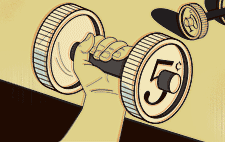|
|
Urban Sprawl
It’s not enough that Chicago has landed in the top five of the nation’s fattest cities for the fourth year in a row, according to Men’s Health. Now Chicago is flirting with fiscal flabbiness as well. The city ranks a lowly 49th among the 50 biggest metropolitan areas in consumer financial health, according to Sperling’s Best Places and State Farm Insurance, which analyzed investments, life insurance, and quality of life to determine households’ financial security.
Chicagoans earned one of their lowest scores on savings, proving that higher income doesn’t necessarily translate to greater financial security. Even though the average Chicago household earns $54,627 a year, well above the national average of $44,684, residents here rank only 33rd in the ratio of income to savings, with an average of $70,000 in total savings per household. In fact, of the ten most fiscally fit cities, only Minneapolis–St. Paul ranks in the top ten for household income.
The survey also seems to suggest a correlation between physical and fiscal fitness. (If people are physically unfit, suggests Bob Mecca, a financial planner in Mount Prospect, they’re at greater risk of becoming disabled or getting turned down for life insurance.) Besides Chicago, two others of the ten most fiscally unfit cities, New Orleans and New York City, are also among Men’s Health‘s heftiest.
|
Most Fiscally Fit Cities
|
Least Fiscally Fit Cities
|
|
| 1. Salt Lake City | 1. Miami | |
| 2. Portland | 2. Chicago | |
| 3. Tampa–St. Petersburg | 3. Los Angeles | |
| 4. Pittsburgh | 4. New Orleans* | |
| 5. Orlando | 5. Milwaukee | |
| 6. Minneapolis–St. Paul | 6. Norfolk | |
| 7. Fort Lauderdale | 7. New York City | |
| 8. Seattle | 8. Orange County (Calif.) | |
| 9. Indianapolis | 9. Raleigh–Durham | |
| 10. Phoenix | 10. Oakland | |
|
* Before Hurricane Katrina
|
||
|
|
Amen to That
Medical bills got you down? Prayer seems to be a popular form of cheap health care, judging by the number of people who incorporate it into their practice of mind-body therapy. In the Midwest, more than 50 percent of people surveyed said they used some form of mind-body healing, including biofeedback, meditation, yoga, tai chi, and prayer, according to the National Center for Complementary and Alternative Therapies. When prayer was excluded from the mix, the number dropped to only 18.2 percent. The difference was even more significant in the South, where 57.2 percent said they used mind-body therapies including prayer. Only 14 percent of Southerners said they used such therapies but did not pray. “It’s not like praying costs anything,” says Grant Ferrier, editor of the San Diego–based Nutrition Business Journal, and it may even confer some non-divine benefit. “If people are in the right frame of mind-calm, settled, serene-they’re much more likely to allow healing.”
| Percentage who use mind-body therapies | ||
|
Including Prayer
|
Excluding Prayer
|
|
| South | 57.2 | 14.0 |
| Pacific states | 52.4 | 22.4 |
| Midwest | 52.0 | 18.2 |
| West | 50.3 | 21.1 |
| Northeast | 46.9 | 16.9 |
Something to Chew On
When it comes to spending on oral hygiene, Chicagoans are slightly down in the mouth. They rank 27th nationwide, according to AC Nielsen, in total overall spending on products for oral hygiene, which includes everything from toothbrushes to mouthwash. Chicago moves up the ranks-to 12th-for spending on breath fresheners. Maybe there’s a reason for that. According to a 2004 survey by the makers of Close-Up toothpaste, folks in the Midwest, along with those in the Northeast, are most likely to be single and looking-and, we presume, most in need of mint-scented breath.




